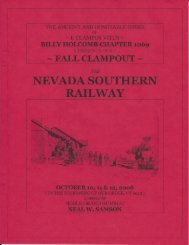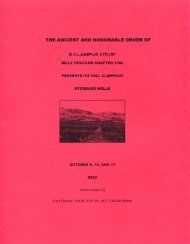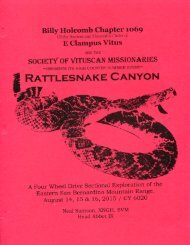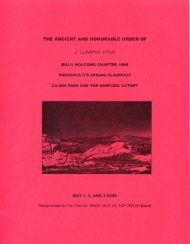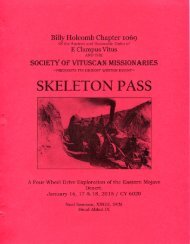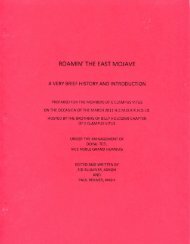6023 Spring Doins ANZA EXPEDITIONS History
You also want an ePaper? Increase the reach of your titles
YUMPU automatically turns print PDFs into web optimized ePapers that Google loves.
THE <strong>ANZA</strong> <strong>EXPEDITIONS</strong>: 1774-1776<br />
In 1774 and again in 1775-1776 Juan Bautista de Anza, an army captain in<br />
the service of Spain, led two expeditions from Mexico to Alta California. The first<br />
was an exploratory trip with a small party to locate a dependable land route to the<br />
Spanish capital at Monterey. Having found such a route, he returned on his<br />
second expedition with colonizers and large herds of livestock to establish the<br />
settlement which would become San Francisco. He was an able leader, and in<br />
the face of unexpected challenges he fully and capably discharged his duties. His<br />
accomplishments on these expeditions were instrumental in the settlement of<br />
California, and he fully deserves his place in the pantheon of the great explorers<br />
of his age.<br />
Spain in the New World<br />
Spain’s involvement in the New World obviously begins with Christopher<br />
Columbus’ historic voyage of 1492. Although he made four voyages to the<br />
Americas, Columbus never set foot on the mainland of either North or South<br />
America. Hernan Cortes landed at Veracruz, Mexico, and established a city there<br />
in 1519, beginning three centuries of Spanish hegemony in the region,<br />
conquering in turn the Aztec, Maya, and Inca civilizations. Spanish administration<br />
in the New World was organized as the Viceroyalty of New Spain in 1535, with its<br />
capital at Mexico City, and the Viceroyalty of Peru in 1542, headquartered at<br />
Lima. The remainder of the 16 th century saw several Spanish entradas into the<br />
uncharted regions of northern Mexico (Old Mexico) and the adjacent lands of<br />
New Mexico, now part of the United States. The explorers were few in number,<br />
and although much was learned, the region remained sparsely populated and<br />
largely unexplored. Spain claimed the area, but did not occupy it.<br />
At the close of the 17 th century Spain sent Jesuit missionaries into what is<br />
now Sonora and Sinaloa, and established a chain of missions in Baja California.<br />
These missions were poor, and it was a constant struggle to keep them supplied.<br />
In 1769, prompted by British and Russian intrusions along the northern coast of<br />
Alta California, Spain sent expeditions by land and sea to establish missions and<br />
presidios all along the coast.<br />
What is now the state of California was first claimed by Juan Cabrillo in<br />
1542 while exploring the coast by sea. His sea voyages were followed by those<br />
of Drake and Cermeno. In 1602 Vizcaino surveyed the California coast and<br />
marked San Diego, Santa Barbara, and Monterey as sites for future colonization.<br />
Despite the knowledge obtained by multiple sea voyages, no one had ever<br />
reached these areas by land and little was known of the country away from the<br />
coast. In the 160 years after Vizcaino, Spain did little to explore, protect, or settle<br />
the region.<br />
2




